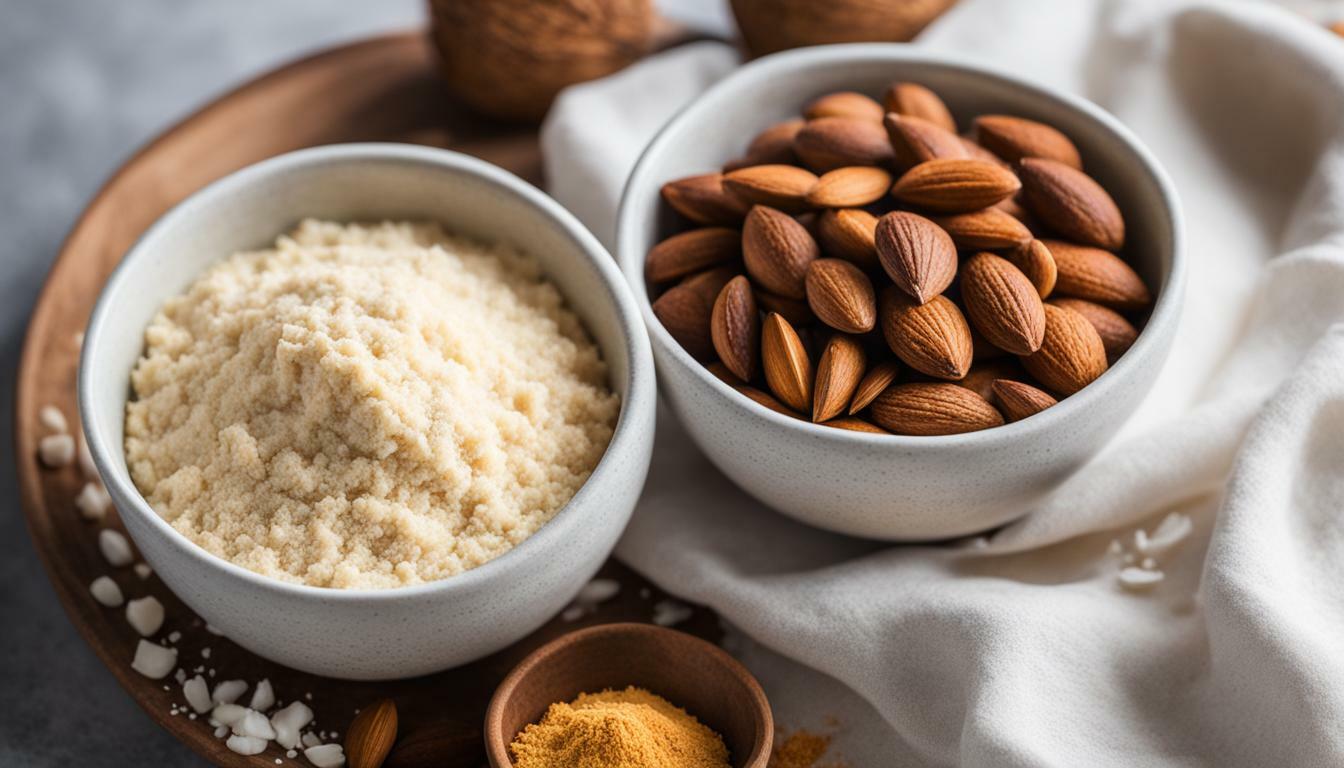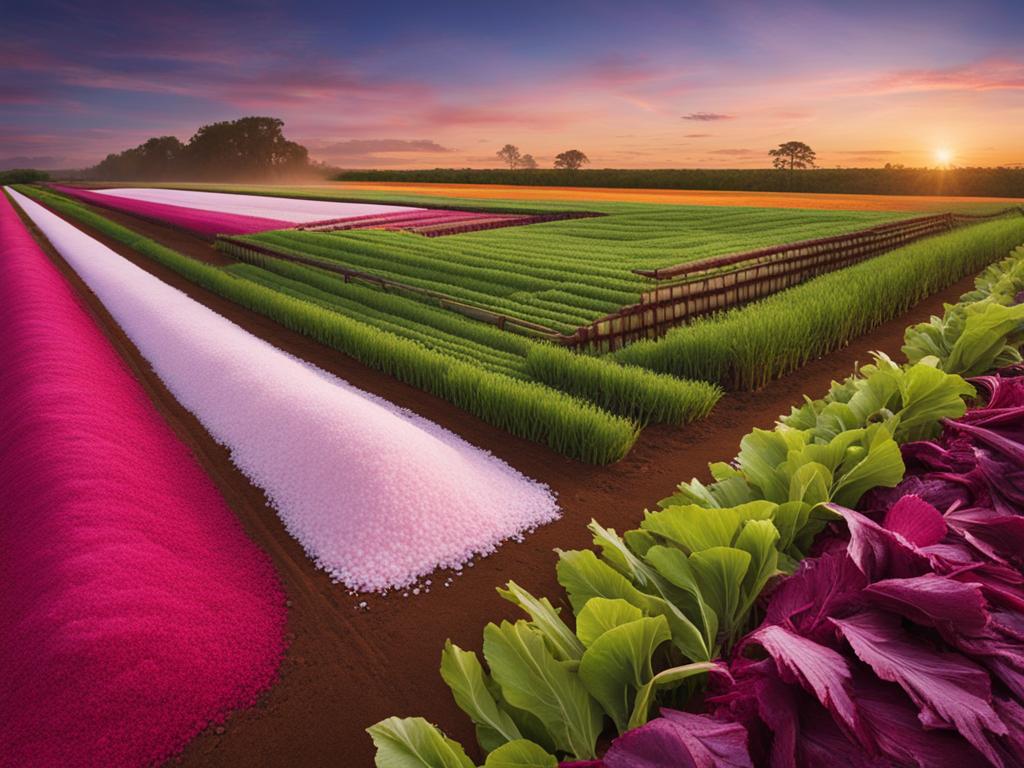Cornstarch and flour are two common ingredients used in cooking and baking, but they are not interchangeable. Understanding the differences between them is key to achieving the desired result in your recipe.
Cornstarch is made from the endosperm of corn kernels and is a fine, powdery substance. Flour, on the other hand, is made by grinding grains, such as wheat, into a fine powder. While they may look similar, their unique properties give them distinct qualities that affect the outcome of your recipe.
Key Takeaways:
- Cornstarch and flour are not interchangeable in recipes, as they have different properties.
- Cornstarch is made from the endosperm of corn kernels, while flour is made by grinding grains.
- Understanding the differences between cornstarch and flour is important for achieving the desired result in your recipe.
What is Cornstarch?
Cornstarch is a fine, white powder made from the endosperm of the corn kernel. It is commonly used in cooking and baking as a thickening agent due to its unique properties. Cornstarch is composed mostly of complex carbohydrates, and unlike flour, it contains no protein or gluten.
Cornstarch is often compared to flour in terms of texture and thickening abilities. While both ingredients can be used to thicken sauces, soups, and gravies, cornstarch has a more neutral flavor and creates a clearer, smoother texture than flour. Cornstarch also has a higher thickening power compared to flour, meaning that a smaller amount is required to achieve the desired consistency.
One key similarity between cornstarch and flour is their versatility in the kitchen. Cornstarch can be used to thicken custards, puddings, and pie fillings, while flour is ideal for making bread, cakes, and pastries. Both ingredients can also be used as a coating for frying or baking, such as in fried chicken or breaded fish.
When to Use Cornstarch
Cornstarch is an excellent choice for thickening clear liquids or recipes where a smooth texture is desired. It is also ideal for recipes that require a quick thickening time, such as stir-fry sauces or fruit fillings. Cornstarch should be mixed with a small amount of cold liquid before being added to a hot mixture to prevent clumping.
When to Use Flour
Flour is best suited for recipes that require a longer cooking time, such as stews or baked goods. It also provides a distinct flavor and texture that cannot be achieved with cornstarch. Flour should be mixed with a fat, such as butter or oil, before being added to a recipe to prevent lumps.
In conclusion, cornstarch and flour are two essential ingredients in any kitchen. While they share some similarities, they differ significantly in texture, taste, and thickening abilities. By understanding the unique properties of each ingredient, you can make informed choices in your cooking and baking, achieving the desired results every time.
Understanding Flour
Flour is a fine powder made from grains such as wheat, rice, barley, and oats. It is a versatile ingredient that is used in a wide range of culinary applications, from baking to thickening sauces and gravies.
There are many types of flour available, each with its unique properties and uses. All-purpose flour is the most common type and can be used for a variety of recipes, including bread, cakes, and cookies. Baking flour, on the other hand, has a lower protein content, making it ideal for delicate baked goods such as pastries and biscuits.
When it comes to texture and thickening abilities, flour is a less powerful thickener than cornstarch. However, it can be used in a more substantial amount to achieve the desired consistency. Flour also imparts a distinct taste and texture that makes it a preferred ingredient in many baked goods.
Flour is commonly used in recipes where a roux, or a mixture of flour and fat, serves as the base for a sauce or gravy. It is also used to coat ingredients before frying, creating a crunchy exterior.
Overall, flour is a versatile ingredient that is essential in any kitchen. Its unique properties make it a popular choice for baking and cooking.
Key Differences between Cornstarch and Flour
When it comes to cooking and baking, cornstarch and flour are two of the most commonly used ingredients for thickening and binding. While they may appear similar at first glance, there are some key differences between the two that can have a significant impact on the final dish.
The most obvious difference between cornstarch and flour is their texture. Cornstarch is much finer and smoother than flour, which can make it ideal for creating a silky-smooth texture in sauces and gravies. Flour, on the other hand, has a coarser texture that can result in a more grainy texture in certain dishes.
Another important difference between cornstarch and flour is their ability to thicken. Cornstarch is much more effective at thickening liquids than flour, and can help create a thicker consistency in recipes such as custards or pudding. Flour, while still useful for thickening, requires more time and heat to do so.
The taste of cornstarch and flour is also different. Cornstarch has a neutral flavor that won’t affect the taste of the dish, while flour can have a slightly doughy or bitter taste if it isn’t cooked thoroughly.
When deciding whether to use cornstarch or flour in a recipe, it’s important to consider the dish’s specific requirements. If a dish requires a smooth texture and fast-acting thickening power, cornstarch is the better choice. However, if a dish requires a coarser texture and a longer cooking time, flour may be the more appropriate option.
Ultimately, while cornstarch and flour share many similarities, their unique properties make them each better suited to certain types of recipes. By understanding these differences, you can make informed choices in the kitchen and create delicious dishes that live up to your expectations.
Culinary Uses of Cornstarch and Flour
Cornstarch and flour are both versatile ingredients used in a wide range of culinary applications. Understanding the unique properties of each can take your recipes to the next level. Here are some common uses for cornstarch and flour:
When to Use Cornstarch:
- Thickening sauces, gravies, and soups: Cornstarch has a higher starch content than flour, making it a more effective thickener. Just remember to mix cornstarch with a cold liquid before adding it to a hot mixture to avoid clumping.
- Breading and frying: Cornstarch creates a crispier coating on fried foods than flour. It can also be used as a gluten-free alternative to flour for coating meats or vegetables before frying.
- Making puddings and custards: Cornstarch helps set puddings and custards without the need for eggs.
When to Use Flour:
- Baking: Flour is a key ingredient in baked goods like bread, cakes, and cookies. It provides structure and texture to these recipes.
- Thickening stews and sauces: While not as effective as cornstarch, flour can also be used to thicken soups, stews, and sauces. It works best when combined with fat (like butter or oil) and cooked for a few minutes before adding liquid.
- Making roux: Roux is a mixture of flour and fat that is used as a base for many sauces and gravies. Cooking flour in fat before adding liquid helps remove any raw flour taste and creates a silky texture.
Ultimately, the decision to use cornstarch or flour in a particular recipe depends on the desired outcome. For a crispy coating on fried foods, cornstarch is the way to go. For baked goods, flour is essential. And when thickening sauces, choosing between cornstarch and flour depends on the desired thickness and texture.
Conclusion
Understanding the differences between cornstarch and flour is key to achieving the desired results in your cooking and baking. While both ingredients may seem similar in texture and color, their unique characteristics set them apart.
When it comes to thickening sauces, gravies, and soups, cornstarch is the go-to ingredient. Its ability to thicken quickly and without altering the taste of the dish makes it a popular choice. Flour, on the other hand, is better suited for baked goods such as bread and cakes, where its ability to create structure and volume is essential.
It is important to note that while cornstarch and flour can be used interchangeably in some recipes, the amount and timing of their use may differ. It is best to follow the specific recipe instructions to ensure the perfect outcome.
In conclusion, knowing when and how to use cornstarch versus flour is essential for achieving the perfect dish. By understanding their differences, you can confidently choose the right ingredient for the task at hand and impress your friends and family with your culinary skills.



